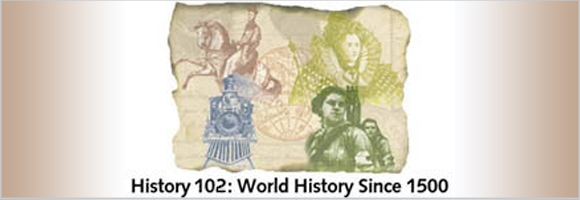
Course Outline
- Six assignments
- Final examination
Course Description
The core focus of History 102 is world history from 1500 to the end of World War I. It uses recently developed scholarship from journals and texts devoted to global history in order to trace demographic, ecological, economic and intellectual links between the continents and Oceania. It introduces these themes by briefly assessing the world before 1500, and then tracing them through the centuries, culminating in the world’s first total war of 1914-18. Special attention is given to epochal shifts in the human condition that led from pre-history to antiquity, the classical age, post-classical transformations, the early modern age, the age of revolutions (economic and political), and the birth of modernity in the early 20th century.
Intended Audience
History 102 is acceptable as a prerequisite for majors in History or International Relations and could serve as well as an elective for first year or second year students at UBC. It should as well be considered by students preparing for the Social Studies concentration in Education. High school faculty teaching world history and comparative civilizations as well as students in post-secondary institutions requiring transferable courses should find the course of interest.
It is also directed at individuals with either a general historical curiosity or interest in a particular phenomenon (e.g. a migration, a political form, an economic system or ideology or belief ) that influenced more than one region of the globe.
Course Objectives
Upon completion of History 102 you will:
- be able to name and locate places (cities, regions, empires and states), land forms and bodies of water which have figured prominently in the human experience.
- have increased your skills of reading, writing and critical analysis.
- be informed about the most recent and in some cases startling new evidence unearthed about the prehistorical experience of your species.
- be able to distinguish between primary and secondary forms of historical evidence found in print and on the internet.
- be able to recognize that history, the written record, is subject to uses and abuses and to different interpretations.
- develop your intellectual curiosity with a basic knowledge about fundamental elements of the human experience some of which you might select for further study.
- be able to trace the historical forces which have shaped your identity not only as regards your particular class, or gender, or ethnicity but as a citizen of the planet living in an
increasingly interdependent world. We all share a common experience. We are all migrants or the descendants of migrants.
Course Overview
The course is separated into four sections divided chronologically but with each containing clearly identified themes which, once introduced, are revisited several times as we proceed. Section One introduces the world before 1500 and carries the narrative to first encounters between Western and indigenous peoples. Section Two covers the 16th to the 18th century, Section Three, 1760-latter 1800s, Section Four, the late 19th and early 20th centuries. They stress common experiences and linkages among the core civilizations of Eurasia and consider, as well, civilizations which evolved in the Americas and Asia. The role of certain rivers and certain oceans and seas around and over which these developments occurred are highlighted. The Mediterranean Sea and Indian Ocean initially, the Atlantic and finally the Pacific subsequently.
Each Section contains 7 to 10 Lessons. These are each self contained with their own theme and thesis or argument. Each ends with a question or two. But they are also linked with others with which they share commonalities.
Course Work
History 102 contains the following graded and non-graded course work:
Graded:
- two document analysis assignments
- an ongoing glossary development assignment
- a map and short answer quiz
- a pictorial assignment
- a comparative essay
- a print/web probe
- a final examination
Non-graded:
- Self-Assessment exercises
Evaluation
A full description of each assignment that you are expected to complete, the marks distribution, and submission policies, is available in the Assignments section of the course web site.
The marks distribution for History 102 is as follows:
| Assignment | Marks in % |
| 1. Glossary Assignment Precis (1% x 10) | 10 |
| 2. Document Analysis #1: First Encounters | 10 |
| 3. Map and Short Answer Quiz | 10 |
| 4. Document Analysis #2: Smith/Marx | 10 |
| 5. Comparative Essay | 20 |
| 6. Pictorial Assignment | 10 |
| 7. Final Examination | 30 |
| Total: | 100 |
Textbooks
Bentley and Ziegler. Traditions and Encounters: A Global Perspective on the Past. 4th Edition. 2007. McGraw Hill, ISBN: 9780073406930.
